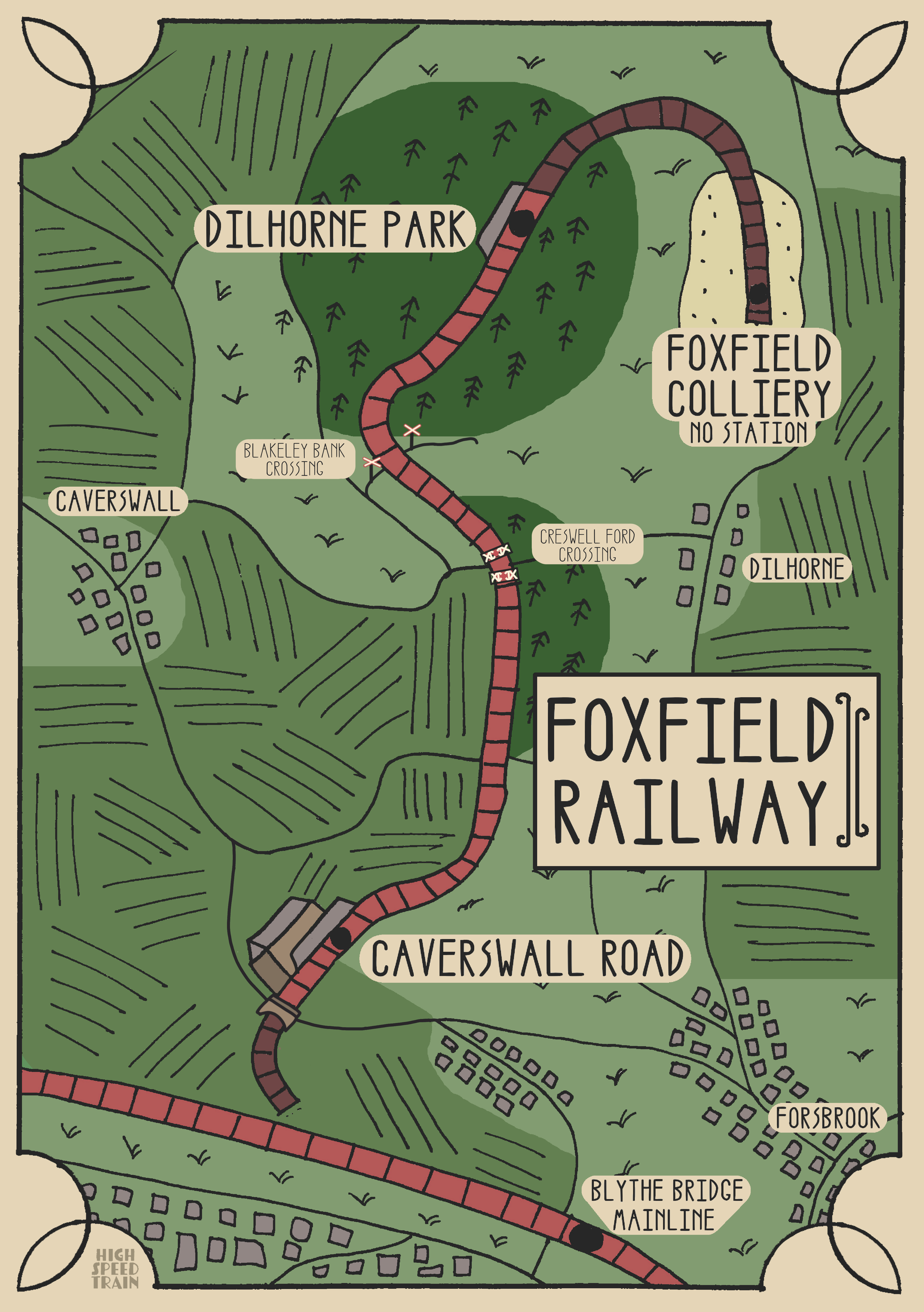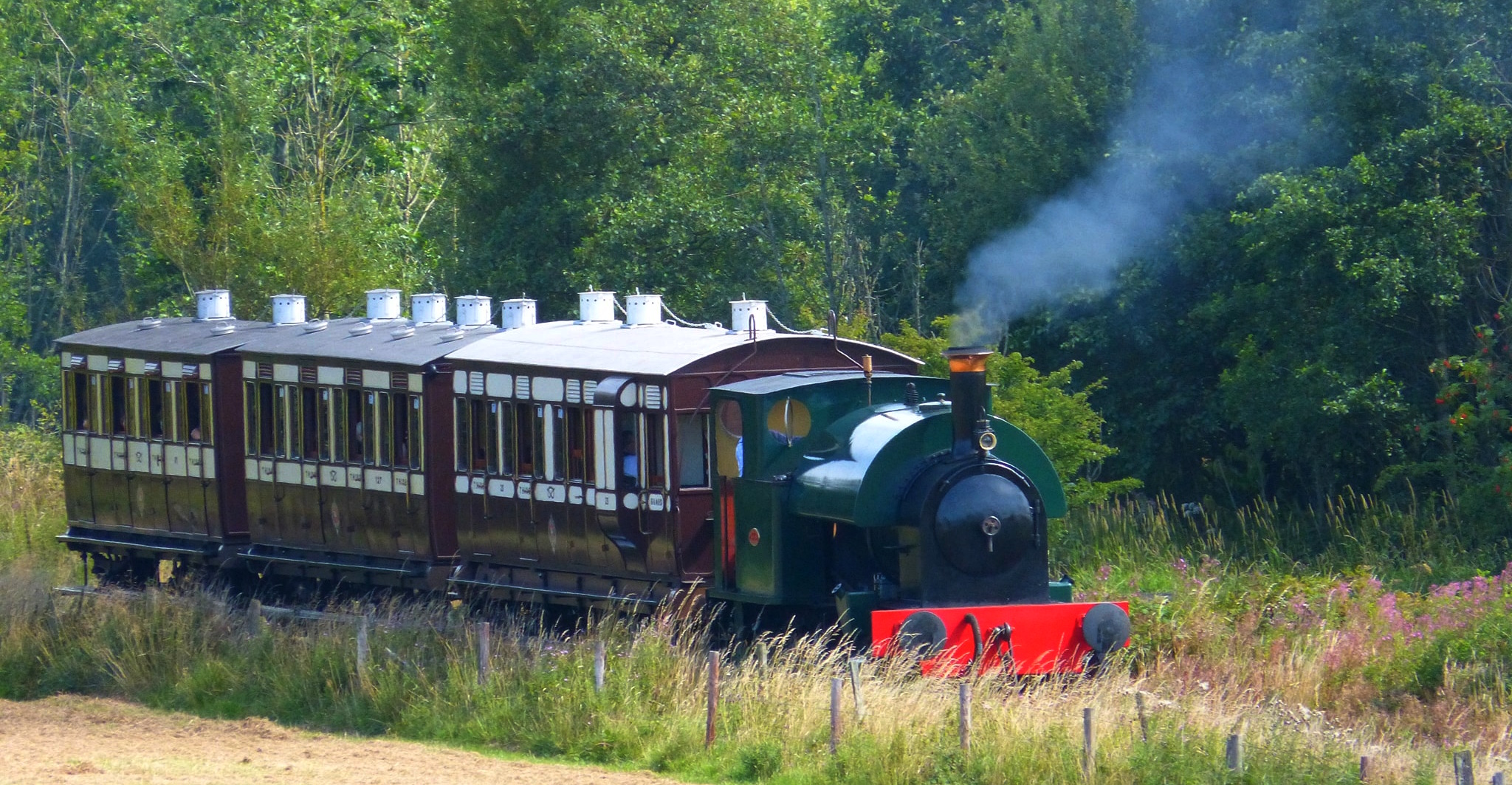Train Services
Find out more about our special route & locomotives
Book your experience
Gift Certificates
Book Train Tickets
Our route through the countryside
What could be more relaxing than a steam train ride through the Staffordshire countryside from the comfort of your own compartment? This 50 minute, return ride from Caverswall Road Station is steeped in history and full of fun. Click here to find out more about planning your day and booking.
The railway was built in 1893 to take coal from Foxfield colliery at Dilhorne to the NSR (North Staffordshire Railway) main line at Blythe Bridge for distribution over the NSR (“Knotty”) network. As expensive earthworks could not be afforded the line negotiates the local landscape by a series of sharp curves and steep gradients. Foxfield Bank varies from 1 in 26 to a fearsome 1 in 19. Read more History
Find out a little more about each key landmark along the way:
Caverswall Road Station – home to Foxfield Railway, miniature railway, the buffet, gift shop, “The Foxfield Arms” bar & museum. See the interior map for the main station building.
Creswell Ford level Crossing – here Caverswall Rd crosses the railway linking the picturesque villages of Caverswall and Dilhorne. One curious and macabre feature of this road is that, along its length, there were a number of unexplained aircraft crashes in the 1940’s and 1950’s. Staffordshire’s own Bermuda Triangle perhaps? A Spitfire from RAF High Ercall crashed in 1942 and the following year a Wellington bomber from RAF Wymeswold suffered a similar fate. In 1944 a Whitley aircraft from RAF Whitchurch Heath crashed on a training exercise. A Canberra jet bomber from RAF Scampton crashed in 1953 hitting the ground almost vertically and causing incredible destruction. In 1954 a de Havilland Venom crashed having taken off on a test flight from Ringway.
The ‘Top Straight’ – this part of the railway, passing through open Staffordshire countryside, is a good place to see our abundant local wildlife. The occasional kestrel can be seen hovering above the fields on the lookout for field mice, voles and beetles. Buzzards wheel around much higher in the sky on the lookout for larger prey including rabbits, pheasants and carrion. More often than not, the silent, rather sinister great grey heron can be seen motionless, standing in one of the pools adjoining the railway, waiting to strike at any unfortunate frog or newt which passes by. On a summer evening the familiar “Too-whit, Too-whoo” of tawny owls in Foxfield Wood may be heard calling to one another.
Dilhorne Park Station – this country halt marks the limit of passenger services. Here you have time to stretch your legs for ten minutes while the loco “runs round” in preparation for the return journey. The bluebells in the adjacent wood are stunningly beautiful in May. At our summer and autumn gala you can, if you choose, walk through Foxfield Wood to the colliery and watch the steam locomotives, full regulator, full gear, ascending the fearsomely steep Foxfield Bank in spectacular fashion.
Foxfield Colliery – the raison d’etre for the Foxfield Railway’s existence. Although the colliery closed more than 50 years ago much of the colliery site remains intact, restoration having been carried out a decade ago by means of a generous grant from the Heritage Lottery Fund. The site is open to visitors at our summer and autumn galas. It can be reached by shuttle bus from Caverwall Rd station or on foot by alighting at Dilhorne Park station. On gala days various activities take place including demonstrations by “Dubsy” the famous ex-Shelton Bar Steelworks crane tank.



Locomotives in use
- Kerr Stuart No 4438 of 1926. A very local engine; built in Stoke on Trent, this locomotive worked locally at Etruria gas works, and then Brookfield foundry before coming to Foxfield for preservation in the 1980s.
- Hawthorn Leslie No 3581 of 1924. “Marston, Thompson & Evershed No 3”. The second locomotive steam at Foxfield in preservation, before moving to the Great Central in the early 1970s, this engine returned to traffic in 2021 after an extensive overhaul.
- Bagnal 2623 of 1940 “Harwarden”. Another engine with very local roots; built in Stafford, her entire working life was spent at Shelton Steelworks in Stoke on Trent.
Knotty Heritage Train
A number of Foxfield enthusiasts formed the Knotty Coach Trust in 2008 in order to restore a number of 4-wheel Victorian NSR carriages. So far two 3rd class vehicles no’s 61 and 127 have been fully restored and a brake 3rd (no. 23). The guard’s compartment has been adapted to carry two wheelchair users. The carriages run regularly at Foxfield behind a period steam loco as the Knotty Heritage Train. The train recreates a “Knotty” suburban train as it would have been in the later years of Victoria’s reign. The group’s next project will be to restore 1st class carriage no 228.

